2017 HONDA CLARITY FUEL CELL heating
[x] Cancel search: heatingPage 5 of 527
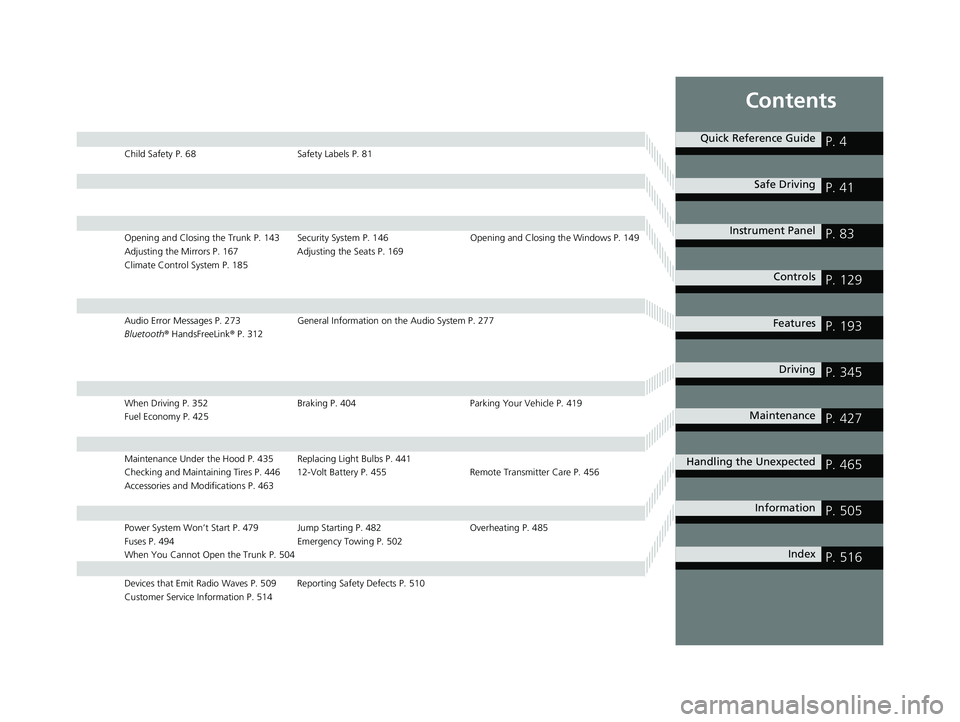
Contents
Child Safety P. 68Safety Labels P. 81
Opening and Closing the Trunk P. 143 Security System P. 146 Opening and Closing the Windows P. 149
Adjusting the Mirrors P. 167 Adjusting the Seats P. 169
Climate Control System P. 185
Audio Error Messages P. 273 General Information on the Audio System P. 277
Bluetooth® HandsFreeLink ® P. 312
When Driving P. 352 Braking P. 404Parking Your Vehicle P. 419
Fuel Economy P. 425
Maintenance Under the Hood P. 435 Replacing Light Bulbs P. 441
Checking and Maintaining Tires P. 446 12-Volt Battery P. 455 Remote Transmitter Care P. 456
Accessories and Modifications P. 463
Power System Won’t Start P. 479 Jump Starting P. 482 Overheating P. 485
Fuses P. 494 Emergency Towing P. 502
When You Cannot Open the Trunk P. 504
Devices that Emit Radio Waves P. 509 Reporting Safety Defects P. 510
Customer Service Information P. 514
Quick Reference GuideP. 4
Safe DrivingP. 41
Instrument PanelP. 83
ControlsP. 129
FeaturesP. 193
DrivingP. 345
MaintenanceP. 427
Handling the UnexpectedP. 465
InformationP. 505
IndexP. 516
17 CLARITY FCV PPO-31TRT6000.book 3 ページ 2016年10月27日 木曜日 午後3時11分
Page 38 of 527
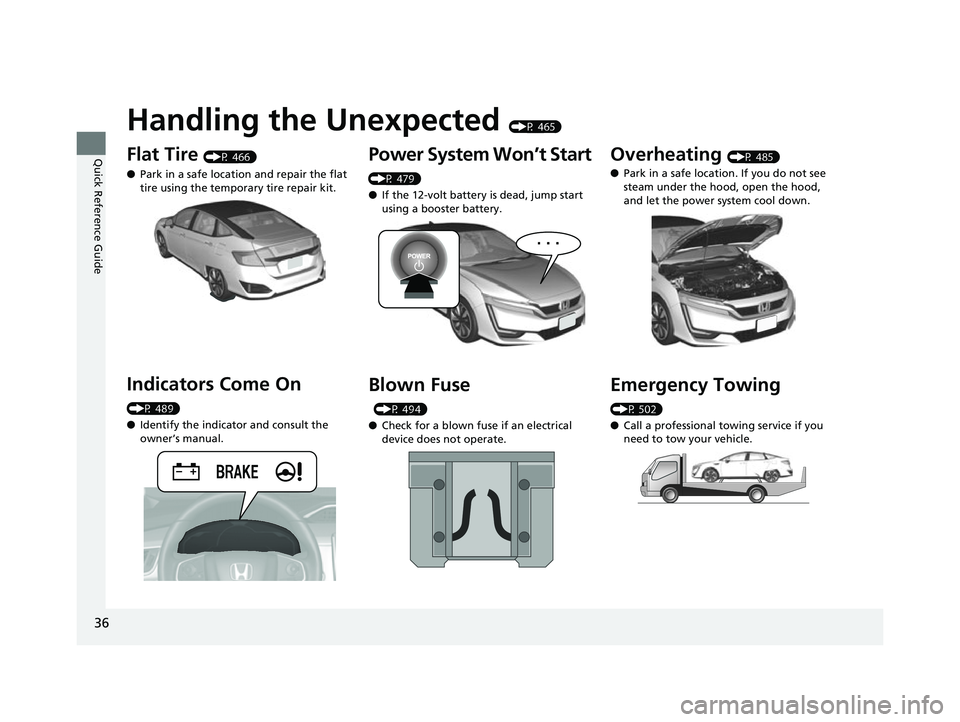
36
Quick Reference Guide
Handling the Unexpected (P 465)
Flat Tire (P 466)
● Park in a safe location and repair the flat
tire using the temporary tire repair kit.
Indicators Come On
(P 489)
●Identify the indicator and consult the
owner’s manual.
Power System Won’t Start
(P 479)
● If the 12-volt battery is dead, jump start
using a booster battery.
Blown Fuse
(P 494)
● Check for a blown fuse if an electrical
device does not operate.
Overheating (P 485)
● Park in a safe location. If you do not see
steam under the hood, open the hood,
and let the power system cool down.
Emergency Towing
(P 502)
●Call a professional towing service if you
need to tow your vehicle.
17 CLARITY FCV PPO-31TRT6000.book 36 ページ 2016年10月27日 木曜日 午後3時 11分
Page 89 of 527
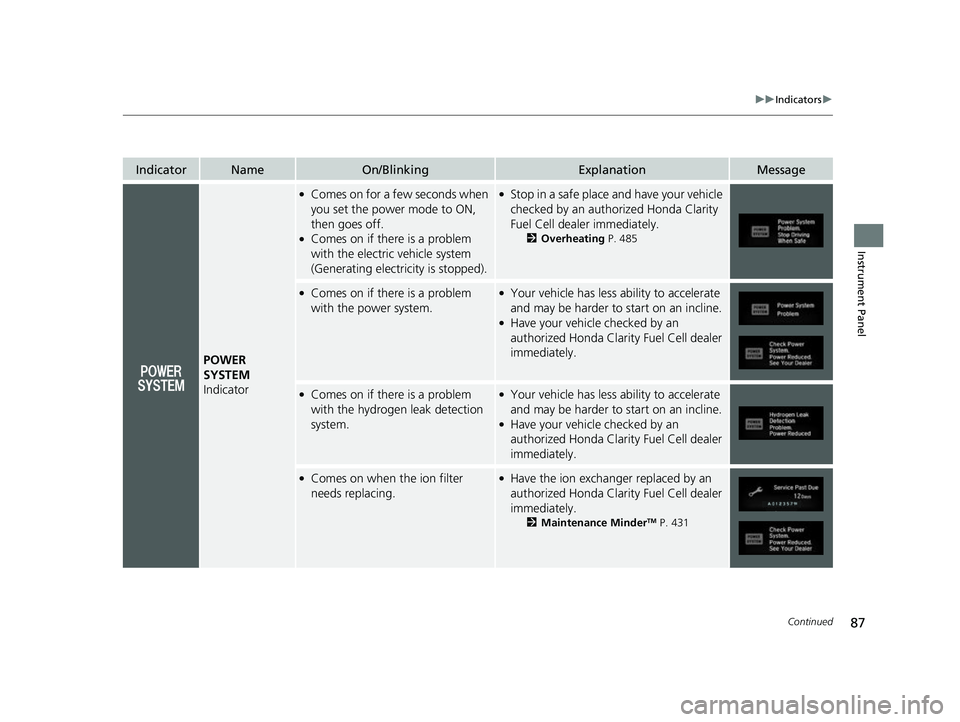
87
uuIndicators u
Continued
Instrument Panel
IndicatorNameOn/BlinkingExplanationMessage
POWER
SYSTEM
Indicator
●Comes on for a few seconds when
you set the power mode to ON,
then goes off.
●Comes on if there is a problem
with the electric vehicle system
(Generating electrici ty is stopped).
●Stop in a safe place and have your vehicle
checked by an author ized Honda Clarity
Fuel Cell dealer immediately.
2 Overheating P. 485
●Comes on if there is a problem
with the power system.●Your vehicle has less ability to accelerate
and may be harder to start on an incline.
●Have your vehicle checked by an
authorized Honda Clarity Fuel Cell dealer
immediately.
●Comes on if there is a problem
with the hydrogen leak detection
system.●Your vehicle has less ability to accelerate
and may be harder to start on an incline.
●Have your vehicle checked by an
authorized Honda Clarity Fuel Cell dealer
immediately.
●Comes on when the ion filter
needs replacing.●Have the ion exchanger replaced by an
authorized Honda Clarity Fuel Cell dealer
immediately.
2Maintenance MinderTM P. 431
17 CLARITY FCV PPO-31TRT6000.book 87 ページ 2016年10月27日 木曜日 午後3時 11分
Page 165 of 527
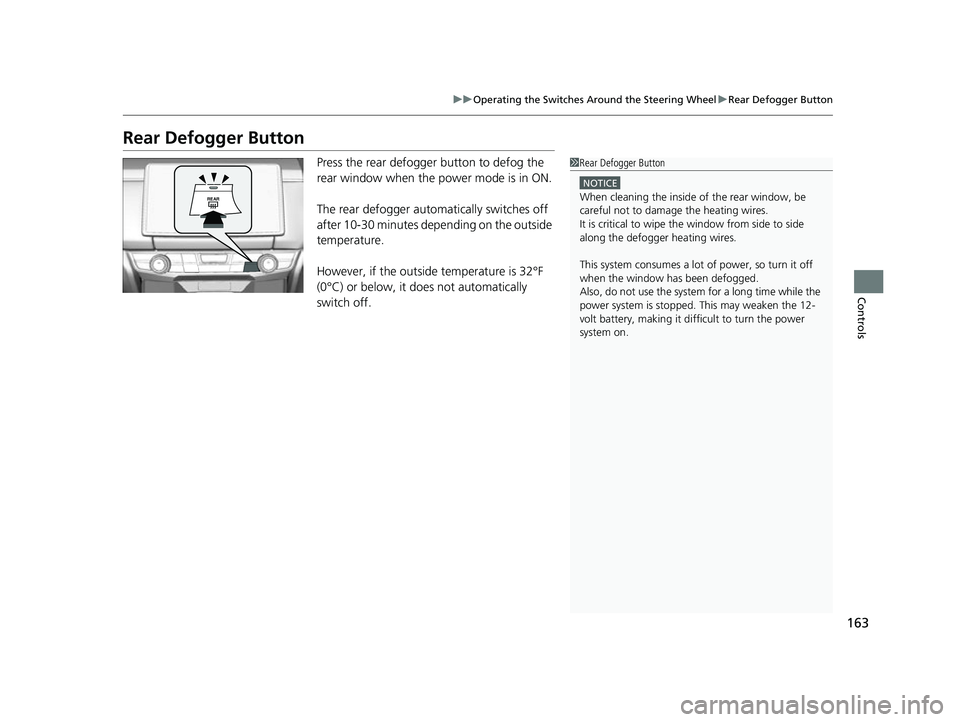
163
uuOperating the Switches Around the Steering Wheel uRear Defogger Button
Controls
Rear Defogger Button
Press the rear defogger button to defog the
rear window when the power mode is in ON.
The rear defogger automatically switches off
after 10-30 minutes depending on the outside
temperature.
However, if the outside temperature is 32°F
(0°C) or below, it does not automatically
switch off.1Rear Defogger Button
NOTICE
When cleaning the inside of the rear window, be
careful not to damage the heating wires.
It is critical to wipe the window from side to side
along the defogger heating wires.
This system consumes a lot of power, so turn it off
when the window has been defogged.
Also, do not use the system for a long time while the
power system is stopped. This may weaken the 12-
volt battery, making it di fficult to turn the power
system on.
17 CLARITY FCV PPO-31TRT6000.book 163 ページ 2016年10月27日 木曜日 午後3 時11分
Page 448 of 527
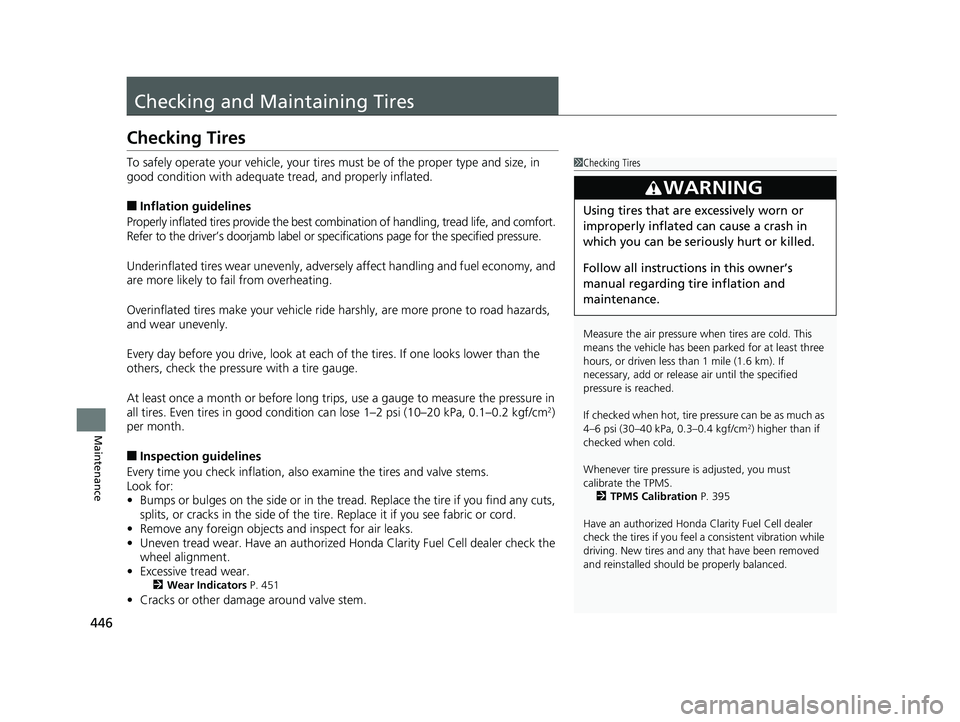
446
Maintenance
Checking and Maintaining Tires
Checking Tires
To safely operate your vehicle, your tires must be of the proper type and size, in
good condition with adequate tread, and properly inflated.
■Inflation guidelines
Properly inflated tires provide the best combination of handlin g, tread life, and comfort.
Refer to the driver’s doorjamb label or spec ifications page for the specified pressure.
Underinflated tires wear unevenly, adversely affect handling and fuel economy, and
are more likely to fail from overheating.
Overinflated tires make your vehicle ride harshly, are more prone to road hazards,
and wear unevenly.
Every day before you drive, look at each of the tires. If one looks lower than the
others, check the pressure with a tire gauge.
At least once a month or before long trips, use a gauge to measure the pressure in
all tires. Even tires in good condition ca n lose 1–2 psi (10–20 kPa, 0.1–0.2 kgf/cm
2)
per month.
■Inspection guidelines
Every time you check inflation, also examine the tires and valve stems.
Look for:
• Bumps or bulges on the side or in the tread . Replace the tire if you find any cuts,
splits, or cracks in the si de of the tire. Replace it if you see fabric or cord.
• Remove any foreign objects and inspect for air leaks.
• Uneven tread wear. Have an authorized Honda Clarity Fuel Cell dealer check the
wheel alignment.
• Excessive tread wear.
2 Wear Indicators P. 451
•Cracks or other damage around valve stem.
1Checking Tires
Measure the air pressure when tires are cold. This
means the vehicle has been parked for at least three
hours, or driven less than 1 mile (1.6 km). If
necessary, add or releas e air until the specified
pressure is reached.
If checked when hot, tire pressure can be as much as
4–6 psi (30–40 kPa, 0.3–0.4 kgf/cm
2) higher than if
checked when cold.
Whenever tire pressure is adjusted, you must
calibrate the TPMS. 2 TPMS Calibration P. 395
Have an authorized Honda Clarity Fuel Cell dealer
check the tires if you feel a consistent vibration while
driving. New tire s and any that have been removed
and reinstalled should be properly balanced.
3WARNING
Using tires that are excessively worn or
improperly inflated can cause a crash in
which you can be seriously hurt or killed.
Follow all instruction s in this owner’s
manual regarding ti re inflation and
maintenance.
17 CLARITY FCV PPO-31TRT6000.book 446 ページ 2016年10月27日 木曜日 午後3 時11分
Page 467 of 527
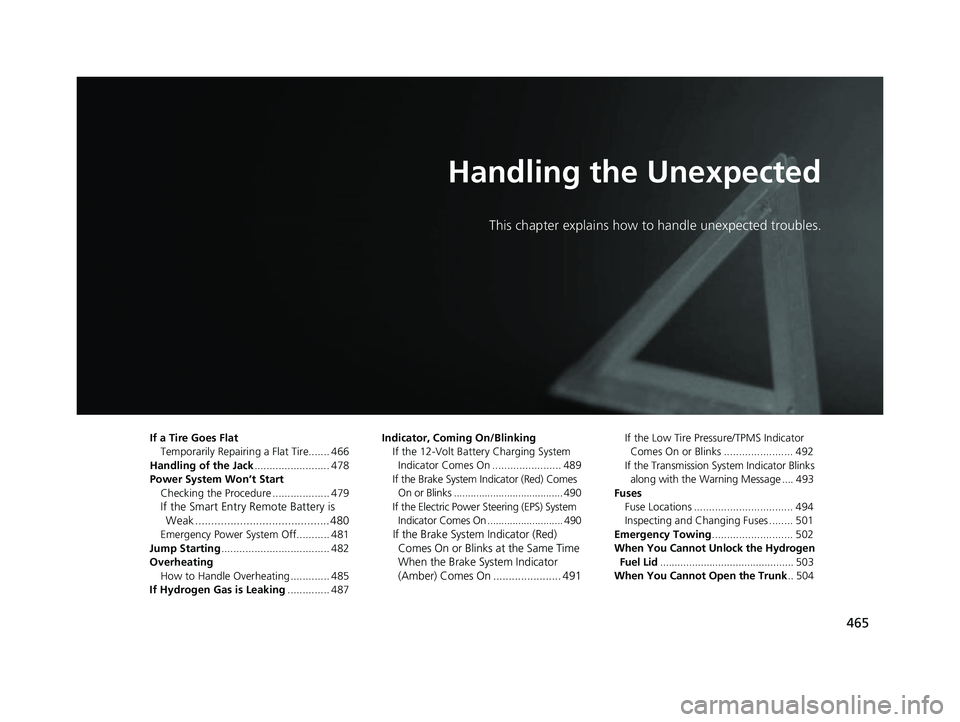
465
Handling the Unexpected
This chapter explains how to handle unexpected troubles.
If a Tire Goes FlatTemporarily Repairi ng a Flat Tire....... 466
Handling of the Jack ......................... 478
Power System Won’t Start Checking the Procedure ................... 479
If the Smart Entry Remote Battery is Weak .......................................... 480
Emergency Power System Off........... 481
Jump Starting .................................... 482
Overheating How to Handle Overheating ............. 485
If Hydrogen Gas is Leaking .............. 487Indicator, Coming On/Blinking
If the 12-Volt Battery Charging System Indicator Comes On ....................... 489
If the Brake System Indicator (Red) Comes On or Blinks ....................................... 490
If the Electric Power Steering (EPS) System Indicator Comes On ........................... 490If the Brake System Indicator (Red) Comes On or Blinks at the Same Time
When the Brake System Indicator
(Amber) Comes On ...................... 491
If the Low Tire Pressure/TPMS Indicator
Comes On or Blinks ....................... 492
If the Transmission System Indicator Blinks along with the Warning Message .... 493
Fuses Fuse Locations ................................. 494
Inspecting and Changing Fuses ........ 501
Emergency Towing ........................... 502
When You Cannot Unlock the Hydrogen Fuel Lid .............................................. 503
When You Cannot Open the Trunk .. 504
17 CLARITY FCV PPO-31TRT6000.book 465 ページ 2016年10月27日 木曜日 午後3 時11分
Page 487 of 527
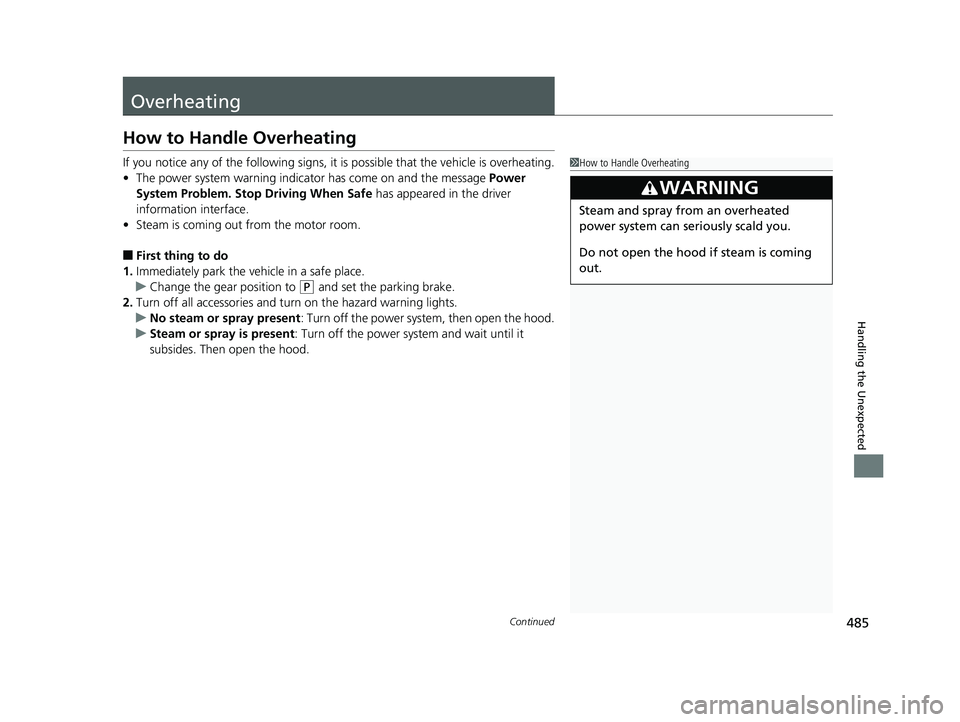
485Continued
Handling the Unexpected
Overheating
How to Handle Overheating
If you notice any of the following signs, it is possible that the vehicle is overheating.
• The power system warning indicator has come on and the message Power
System Problem. Stop Driving When Safe has appeared in the driver
information interface.
• Steam is coming out from the motor room.
■First thing to do
1. Immediately park the vehicle in a safe place.
u Change the gear position to
(P and set the parking brake.
2. Turn off all accessories and turn on the hazard warning lights.
u No steam or spray present: Turn off the power system, then open the hood.
u Steam or spray is present : Turn off the power system and wait until it
subsides. Then open the hood.
1 How to Handle Overheating
3WARNING
Steam and spray from an overheated
power system can seriously scald you.
Do not open the hood if steam is coming
out.
17 CLARITY FCV PPO-31TRT6000.book 485 ページ 2016年10月27日 木曜日 午後3 時11分
Page 488 of 527
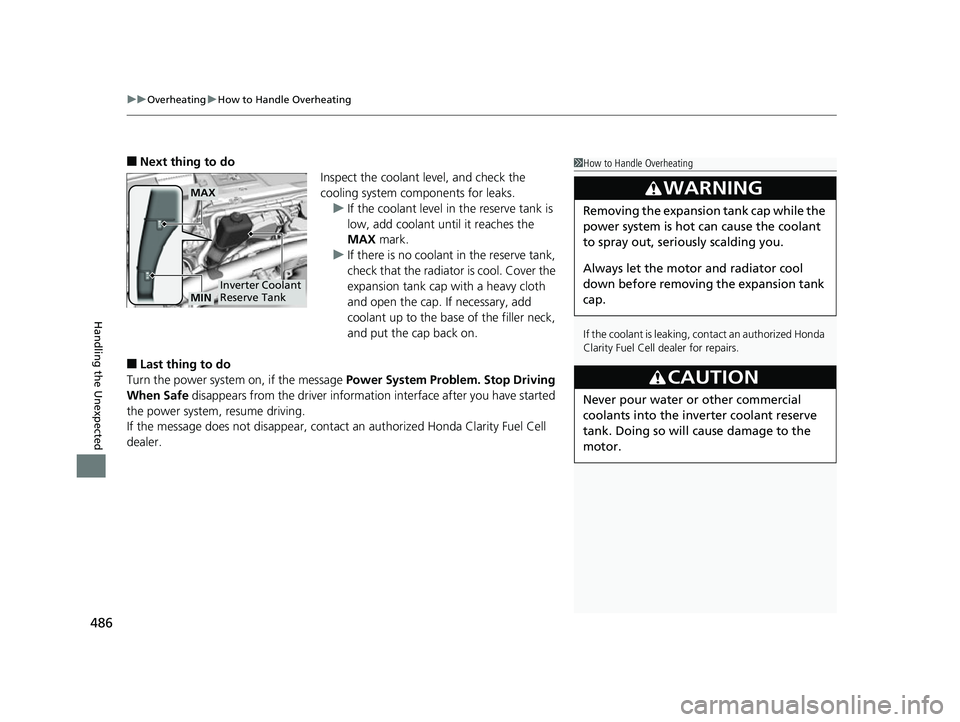
uuOverheating uHow to Handle Overheating
486
Handling the Unexpected
■Next thing to do
Inspect the coolant level, and check the
cooling system components for leaks.u If the coolant level in the reserve tank is
low, add coolant until it reaches the
MAX mark.
u If there is no coolan t in the reserve tank,
check that the radiator is cool. Cover the
expansion tank cap with a heavy cloth
and open the cap. If necessary, add
coolant up to the base of the filler neck,
and put the cap back on.
■Last thing to do
Turn the power system on, if the message Power System Problem. Stop Driving
When Safe disappears from the driver informatio n interface after you have started
the power system, resume driving.
If the message does not disappear, contact an authorized Honda Clarity Fuel Cell
dealer.
1 How to Handle Overheating
If the coolant is leaking, contact an authorized Honda
Clarity Fuel Cell dealer for repairs.
3WARNING
Removing the expansion tank cap while the
power system is hot can cause the coolant
to spray out, seri ously scalding you.
Always let the motor and radiator cool
down before removing the expansion tank
cap.
3CAUTION
Never pour water or other commercial
coolants into the inverter coolant reserve
tank. Doing so will ca use damage to the
motor.
MAX
Inverter Coolant
Reserve TankMIN
17 CLARITY FCV PPO-31TRT6000.book 486 ページ 2016年10月27日 木曜日 午後3 時11分